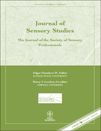STATISTICAL ANALYSIS OF HIERARCHICAL SORTING DATA
Abstract
ABSTRACT
Hierarchical sorting is a data collection methodology used in sensory analysis, which consists in asking people to provide a succession of categorization tasks: in the first step, they have to divide the set of objects into groups and in the second step, they can, if they want, subdivide these groups into finer groups, etc., until they judge the final groups of objects to be homogeneous.
This article describes a new methodology to analyze these data: multiple factor analysis (MFA). MFA allows balancing the part of each subject into the analysis according to the number of subdivisions provided. MFA provides usual factor analytic representations (object representations) and specific representations (in particular subject representations and levels of hierarchy representations).
This method is illustrated with an example in which 89 children performed a hierarchical sorting task on 16 cards. It is conducted with the R SensoMineR package.
PRACTICAL APPLICATIONS
The aim of this article is to present a new approach of analyzing hierarchical sorting data. We show how the outputs of the proposed methodology can be interpreted using an example. This methodology is particularly helpful if we are interested in the process of sorting used by the subjects.




